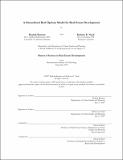A streamlined real options model for Real Estate Development
Author(s)
Barman, Baabak; Nash, Kathryn E
DownloadFull printable version (419.5Kb)
Other Contributors
Massachusetts Institute of Technology. Dept. of Urban Studies and Planning.
Advisor
David Geltner.
Terms of use
Metadata
Show full item recordAbstract
This thesis introduces a streamlined model that incorporates the value of the real options that exist in real estate development projects. Real options add value to a project by providing developers with flexibility to minimize downside risk or take advantage of upside potential as conditions change from deterministic expectations. Though developers currently incorporate this value into their decision making using intuition and judgment, the model presented here provides a tool with which developers can value options in a rigorous and quantitative fashion. Though the model should not be used as a comprehensive land residual model, it serves as a powerful proof of concept for real options analysis in the field of real estate. Further, it can be used to measure the relative value and risk of projects with and without real options. The model is based on both the traditional economic and the more recent engineering real options methodologies. Both approaches have been applied to real estate development projects, but have not yet caught on due to their newness and complexity. The streamlined model incorporates the elements of both methodologies that are most applicable to current development practice. In addition, the model is simplified and tailored to existing valuation techniques. The added benefit of this "hybrid" approach is that it reduces the learning curve associated with real options analysis so as to encourage its adoption in the real estate field in the short term. (cont.) The model uses Monte Carlo simulations in Excel and is targeted towards specific options scenarios commonly faced by developers; specifically, the options to phase a project, choose among multiple uses, and defer development. A case study demonstrates the model, and compares the results of building two phased buildings versus a single larger building on the same site. The results show that the phased program results in less risk and a higher expected net present value than the single building program, while the option to defer development adds significant value to both programs.
Description
Thesis (S.M. in Real Estate Development)--Massachusetts Institute of Technology, Dept. of Urban Studies and Planning, 2007. This electronic version was submitted by the student author. The certified thesis is available in the Institute Archives and Special Collections. Includes bibliographical references (leaves 52-53).
Date issued
2007Department
Massachusetts Institute of Technology. Department of Urban Studies and PlanningPublisher
Massachusetts Institute of Technology
Keywords
Urban Studies and Planning.